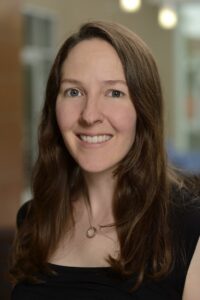Posted By: Sara Cullinan, PhD, Deputy Editor, AJHG
Each month, the editors of The American Journal of Human Genetics interview an author of a recently published paper. This month we check in with Alexis (@alexisjbattle) to discuss her paper “Redefining tissue specificity of genetic regulation of gene expression in the presence of allelic heterogeneity.”
SC: What prompted you to start working on this project?

SC: What about this paper/project most excites you?
AB: Our work and related efforts will help identify the correct genes, cell-types, and contexts through which disease-associated loci act, leading to improved understanding of disease mechanism and hopefully better identification of potential therapeutic targets.
I am also very excited about our evidence that genetic effects on gene expression act in more highly tissue-specific and context-specific patterns than previously appreciated. This may help explain why we haven’t identified target genes for some disease loci, and prompt the field to consider further analysis of single-cell, spatial, and time series transcriptomic data to include more diverse contexts where variants may act.
SC: Thinking about the bigger picture, what implications do you see from this work for the larger human genetics community?
AB: Improved disentangling of disease-associated genetic loci to identify causal genes, pathways, and cell-types is a critical goal in both therapeutic development and understanding genetic architecture of disease.
Thinking toward the next few years, the ability to disentangle multiple causal variants within a locus will be particularly helpful as we move toward very large, biobank scale association studies that have power to identify multiple variants even with small effects and low allele frequencies, including variants that act in different cell types or contexts. Looking forward, I’m also excited about extending our approaches to run across studies with individuals of different genetic ancestries, having different patterns of linkage disequilibrium, allele frequencies, and even different causal variants.
SC: What advice do you have for trainees/young scientists?
AB: I would advise young scientists in computational genomics to solidify their technical foundations early, and then explore diverse applications and cutting-edge problems while they have the freedom of their PhD and postdoc years. Read a lot and talk to scientists within and outside your lab to help develop your ability to identify promising research directions. Finally, try to find a style of work you enjoy, whether that’s coding-heavy, more mathematical, or more focused on the biology. Research can have ups and downs over time, so enjoying the day-to-day process along with being motivated by the big picture can really help during periods of frustration or when a project isn’t going perfectly.
SC: And for fun, tell us something about your life outside of the lab.
AB: The pandemic has certainly restricted my “outside” life in the past couple years, but one thing I enjoy lately is skiing with my son on the weekends. He’s already starting to challenge me on the slopes – he’s the one pushing me to try new things I’m probably too old to learn, like little jumps in the terrain park.
